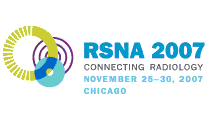
Abstract Archives of the RSNA, 2007
SST04-02
Quantification of Renal Perfusion Using Contrast-enhanced Ultrasound
Scientific Papers
Presented on November 30, 2007
Presented as part of SST04: Genitourinary (Ultrasound)
Sébastien Mulé, Abstract Co-Author: Nothing to Disclose
Christine Caroline Hoeffel MD, Presenter: Nothing to Disclose
Laurent Huwart MD, Abstract Co-Author: Nothing to Disclose
Olivier Helenon, Abstract Co-Author: Nothing to Disclose
Alain Herment, Abstract Co-Author: Nothing to Disclose
Jean-Michel Correas MD, Abstract Co-Author: Nothing to Disclose
To assess kidney blood flow quantification using contrast-enhanced ultrasound with an isolated perfused pig kidney model.
After approval by the animal ethics committee, 4 pig kidneys were explanted and connected to an ex-vivo perfusion phantom. A 50 % diluted solution of SonoVue® (Bracco, Italy) was infused in the venous side of the circuit at 0.5 mL/min. CE-US was performed with an Applio system (Toshiba, Japan) using a linear transducer (10L4) and pulse inversion imaging. Each kidney was perfused with Celsior® liquid (Imtix Sangstat, France) at different flow rates (30, 50, 70 and 90 mL/min). For each flow rate, 19 to 31 destruction–reperfusion kinetics were performed. Four different ROIs were set on the anterior and posterior cortex, medullary and segmental artery. Signal intensity measurements were performed in linear units using a dedicated software developed under Matlab®. Curve fitting was performed after normalization of the post-destruction frames using the mathematical model y = A(1-e(-Bt)), with A estimated blood volume and B estimated microbubble velocity, and AxB estimated blood flow (EBF). EBF was compared to the actual blood flow rate used, both before and after compensation for the arterial time-intensity decrease by dividing AxB by the average signal intensity in the artery before destruction.
EBF was significantly correlated with the input flow rate defined by the pump outflow for the anterior cortical and medullary ROIs (r=0.99, 0.75, 0.86, 0.92 and 0.92, 0.95, 0.98, 0.99; respectively) after compensation for the arterial time-intensity decrease, whereas there was no correlation without this compensation. For the posterior cortical ROI, a significant correlation after normalization to the artery was obtained for only two kidneys (r=0.93, 0.95), due to stronger microbubble attenuation in the posterior cortex.
Renal cortex and medullary blood flow can be estimated using CE-US, giving that the arterial time-intensity decrease is being compensated for. Microbubble attenuation must however be taken into account, especially for the posterior cortex.
Precise assessment of renal blood flow using CE-ultrasound is feasible
Mulé, S,
Hoeffel, C,
Huwart, L,
Helenon, O,
Herment, A,
Correas, J,
Quantification of Renal Perfusion Using Contrast-enhanced Ultrasound. Radiological Society of North America 2007 Scientific Assembly and Annual Meeting, November 25 - November 30, 2007 ,Chicago IL.
http://archive.rsna.org/2007/5006480.html

